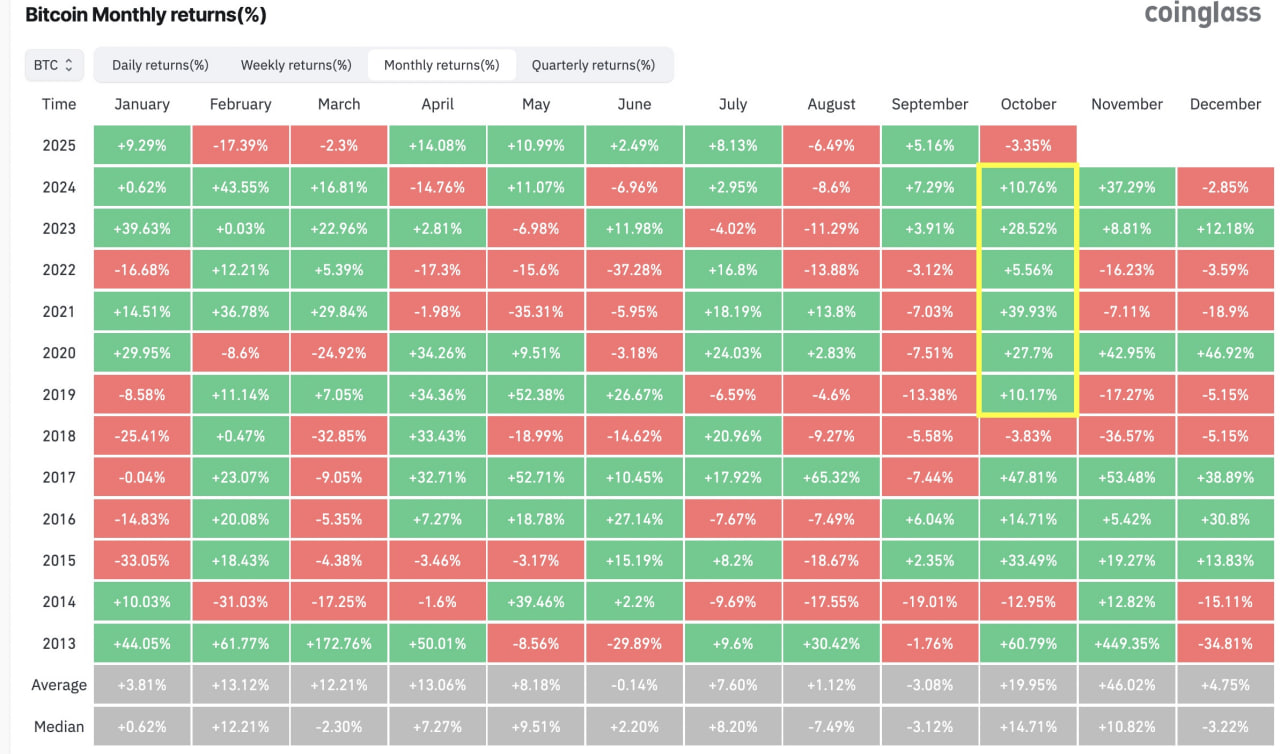Monthly bitcoin yield, %
October 2025 went down in history as the first “red Uptober” in the last seven years. After six years of steady growth, bitcoin broke the tradition, showing a decline of more than 3%, and sparked a new wave of discussions about whether the nature of the cycle has changed or if the market is simply pausing before the next surge.
How October lost its status as a lucky month
October has long been considered a lucky month for bitcoin holders. Since 2013, the cryptocurrency has closed in the red only twice — in 2014 and 2018. All subsequent six years brought steady growth, reinforcing the month’s nickname “Uptober”.
This year was an exception. Bitcoin lost about 3.35%, and the sentiment index fell to its lowest in six months. Analyst Jelle noted on X that without a “strong green candle” on the last day, October would close red for the first time in seven years. And that’s exactly what happened.
Among the reasons for the decline are trade tensions between the US and China, which triggered a spike in volatility in mid-month, and statements from the Fed. Although the regulator cut the rate by 0.25 p.p., the market took this not as a stimulus, but as a signal of uncertainty.
Trader TraderAAG succinctly summed up the mood:
“October closed negative for the first time in seven years. This month sobered up the market — and made many remember that growth is not endless.”
“Uptober” failed: what are the reasons
According to CoinMarketCap, the crypto market capitalization fell by 0.46% to $3.69 trillion. Bitcoin traded around $110,000, and Ethereum lost 1.7%, dropping to $3,850.
Analyst Crypto Damus called this October an “anomaly”. Usually, this month is second only to November in returns, but now — one of the worst in recent years. According to him, the market “ran out of steam” after the summer rally, and large players preferred to lock in profits to free up liquidity before year-end.
Some analysts link the decline to a sharp drop in trading volumes and the exit of retail investors. Glassnode data shows that the share of short-term holders (coins less than a month old) reached 17% — the highest since May. This indicates an excess of speculative capital, which increases price pressure during corrections.
November may bring bulls back to the market
After a series of weak weeks, traders are trying to figure out if November will be a turning point. Historically, this month is considered the best for bitcoin: since 2013, the average November return has been 46%, and the total Q4 gain — about 78%.
According to CoinGlass, in 2023 bitcoin rose 57% in the last months of the year, and in 2024 — by 48%. In 2017, the autumn-winter rally became legendary — +480% in two months.
Some market participants believe that the “red October” may be just a warm-up before a strong November impulse. Analyst Crypto Rover reminded that even after negative months, the market often rebounded:
“In 2018, bitcoin fell 36% in November, but recovered within six months. The correlation between weak Octobers and the following months is minimal.”
Skeptics expect the correction to continue
However, not everyone shares the optimism. Some analysts warn that a weak October may signal a slowdown in the cycle. According to expert Timothy Peterson, historically after a negative October, growth in the next three months averages no more than 11%, while after a strong October — about 21%.
“There is almost no connection between months, but the dynamics show: after a weak period, the market moves more cautiously,” notes Peterson.
Other analysts point to macroeconomics. After Jerome Powell’s comments about the uncertainty of the December rate decision, investors began to cut risky positions, and the share of stablecoins in crypto portfolios increased.
Long-term signals remain bullish
Despite the short-term correction, the market structure remains resilient. There are no signs of mass selling from long-term investors on the blockchain, and the share of large wallets, according to CryptoQuant, continues to grow.
Large holders use declines to accumulate, as was the case in 2019 and 2020 before the start of new growth cycles. Given historical patterns, November and December traditionally become a turning point — especially if the Fed starts preparing to ease policy.
What’s next?
Bitcoin closed October in the red for the first time in seven years, but this is not necessarily a signal to panic. History shows that the strongest rallies often begin after periods of calm and corrections.
If November confirms the seasonal trend, the market may return to upward movement and end the year above $130,000–150,000, especially amid expectations of new liquidity inflows and growing institutional demand.
Read more: Sam Bankman-Fried stated that FTX was solvent and blamed lawyers for the company’s collapse






